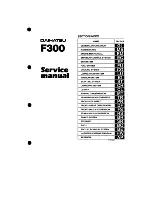
Electric refrigeration
When using 110-Volt external power,
make sure the house or
cam psite power supply agrees with the specifications printed on
the outside receptacle of the vehicle before hooking up.
1. Move switch “ B” to the “ AC 120 V” position.
2. Make sure GAS knob "F ” is in "OFF" position.
3. Turn therm ostat control knob “ A ” to "M A X ” .
When the refrigerator interior is sufficiently cold, turn therm o
stat from “ MAX” to an interm ediate setting.
W hen electric refrigeration is not needed, turn therm ostat
“ O FF” .
The 12-Volt power supply from the vehicle battery can be
used when the engine is running. W e recommend this
method only while driving. Remember to check the battery
control lights!
1. Move switch “ B” to the “ DC 12 V” position.
2. Make sure GAS knob “ F” is in “ OFF" position.
3. Turn thermostat control knob “ A" to an interm ediate setting.
4 As soon as vailable, switch back to an external power
supply to conserve battery power.
Tw elve-Volt refrigeration is protected against overload by a
10-Amp fuse “ E” in the switch knob panel.
16
Defrosting the refrigerator
Keep an eye on the ice formation on the evaporator core. Too
much ice build-up reduces cooling efficiency. We recom m end
frequent defrosting. Never let the ice thicken more than 1/8" (3-4
mm).
Gas refrigeration -
• turn GAS knob “ F” to “ OFF”
• turn thermostat control knob “ A ” to “ OFF” .
Electric refrigeration -
• turn thermostat control knob “ A ” to “ OFF” ,
or
• disconnect plug from the electrical outlet located on the left
side wall of the upp e r storage com partm ent in the sink c a b i
net.
Never use electrical heating gadgets or boiling w ater for
quick defrosting. They can cause serious dam age to the
refrigerator.
Empty the refrigerator, leave the door open and let the ice melt
gradually into the catch basin below. Pull the basin out to empty
the water and dry off before reinstalling.
Cleaning the refrigerator
Clean the refrigerator interior with a solution of lukewarm water
and baking soda.
Clean the seal around the door with clear water only. C hem i
cal additives, oil and grease must not come in contact with
the door seal to keep it air tight.
www.WestfaliaT3.info - a useful website for owners and enthusiasts of VW Westfalia T25 / T3 / Vanagon Campervans







































